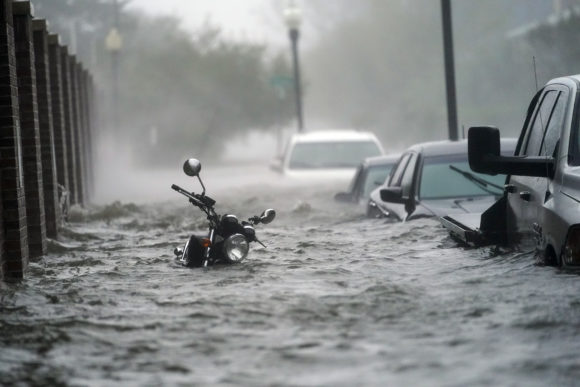Hurricane Sally is not expected to cause a major insurance loss – compared to events such as the ongoing wildfires in California, Oregon, and Washington, or Hurricane Laura, according to AM Best. As the storm was more of a flood event, the ratings agency said, most of the losses will be covered by the U.S. National Flood Insurance Program (NFIP).
More than two-thirds of flood coverage written in Alabama is federal, so flood losses for the NFIP will be “significant,” commented AM Best in a report titled “Potentially Severe Flood Losses from Hurricane Sally.”
Hurricane Sally made landfall early Wednesday morning on Sept. 16, dropping massive amounts of rain in Alabama and the Florida Panhandle, which was exacerbated by the slow pace of the storm—about three miles per hour, in its report published on Sept. 17.
According to NFIP estimates as of July 2019, only eight of the roughly 50 counties vulnerable to moderate to high flash flood risk from Sally have more than 25% of properties insured, AM Best said, noting that, as a result, the gap between insured and economic losses is likely to be wide.
“Although a major flood event would reduce some direct loss exposure to the insurance industry, we expect significant auto claims from damage to automobiles due to storm surge,” but only seven insurers have concentrations larger than 10% in this line in Alabama,” the report continued.
The ratings agency said the Alabama private flood coverage market is very concentrated with 10 companies accounting for around 91% of premium.
While NFIP provides a majority of coverage for flood (82%), some insurers have significant exposure to private flood, especially the 10 market share leaders, said the report. However, their exposure to private flood in Alabama is low at less than 4% of each of their overall private flood direct premiums written, the report continued.
“Hurricane Harvey caused damage to over one million vehicles—the largest auto loss in U.S. history after rainfall topped nearly four feet. We expect losses to be less than Hurricane Harvey’s, which had an impact in the heavily populated metropolitan area around Houston.”
As Sally was more of a flood than a wind event, AM Best predicted that homeowners’ losses are likely to be more limited. “However, a standard homeowner’s policy will cover water damage from rain as long as the storm has ‘opened up’ a hole in the roof,” the report explained.
NFIP policies offer up to $250,000 in coverage for a home and up to $100,000 for belongings. Private flood insurance can either supplement a NFIP policy by offering higher limits for homes with a high property value or replace it completely, said AM Best.
The reinsurance program for 2020 attaches for NFIP losses greater than $4 billion, added the ratings agency.
Photograph: Cars and a motorcycle are underwater as water floods a street on Wednesday, Sept. 16, 2020, in Pensacola, Fla. Hurricane Sally made landfall Wednesday near Gulf Shores, Alabama, as a Category 2 storm, pushing a surge of ocean water onto the coast and dumping torrential rain. Photo credit: AP Photo/Gerald Herbert.
Related:
- Update: Weakened Hurricane Sally Leaves Gulf Coast With Flooding
- Oil Industry Begins Cleaning Up, Restarting Gulf Operations After Hurricane Sally
- Slowness, Not Speed, of Hurricanes Like Sally Becoming Major Concern
Topics Catastrophe Natural Disasters Profit Loss Flood Hurricane AM Best Alabama
Was this article valuable?
Here are more articles you may enjoy.



 10 Highest Class-Action Settlements in 2025 Eclipsed $70B Total: Duane Morris
10 Highest Class-Action Settlements in 2025 Eclipsed $70B Total: Duane Morris  New York State Police Report 37-Vehicle Pileup on I-81 Near Syracuse
New York State Police Report 37-Vehicle Pileup on I-81 Near Syracuse  SIAA Announces Strategic Partnership With Progressive
SIAA Announces Strategic Partnership With Progressive  Alliant Latest to Sue Howden US Over Alleged ‘Smash-and-Grab’ Poaching
Alliant Latest to Sue Howden US Over Alleged ‘Smash-and-Grab’ Poaching 

